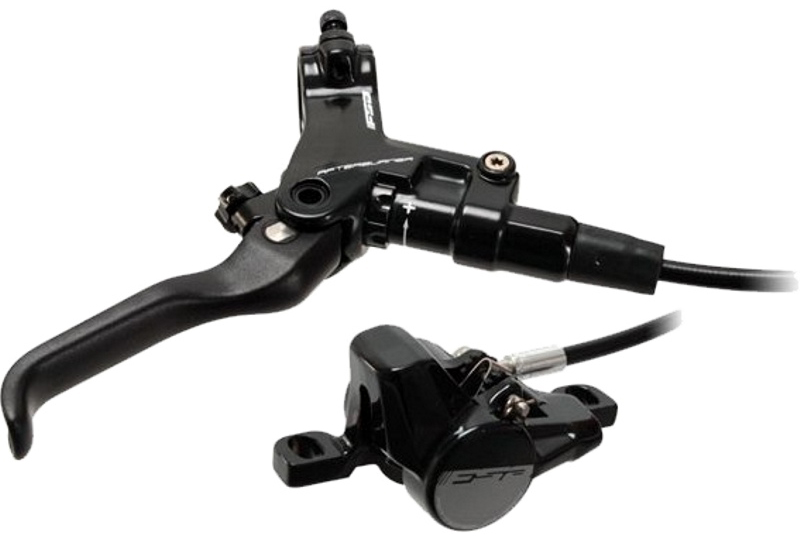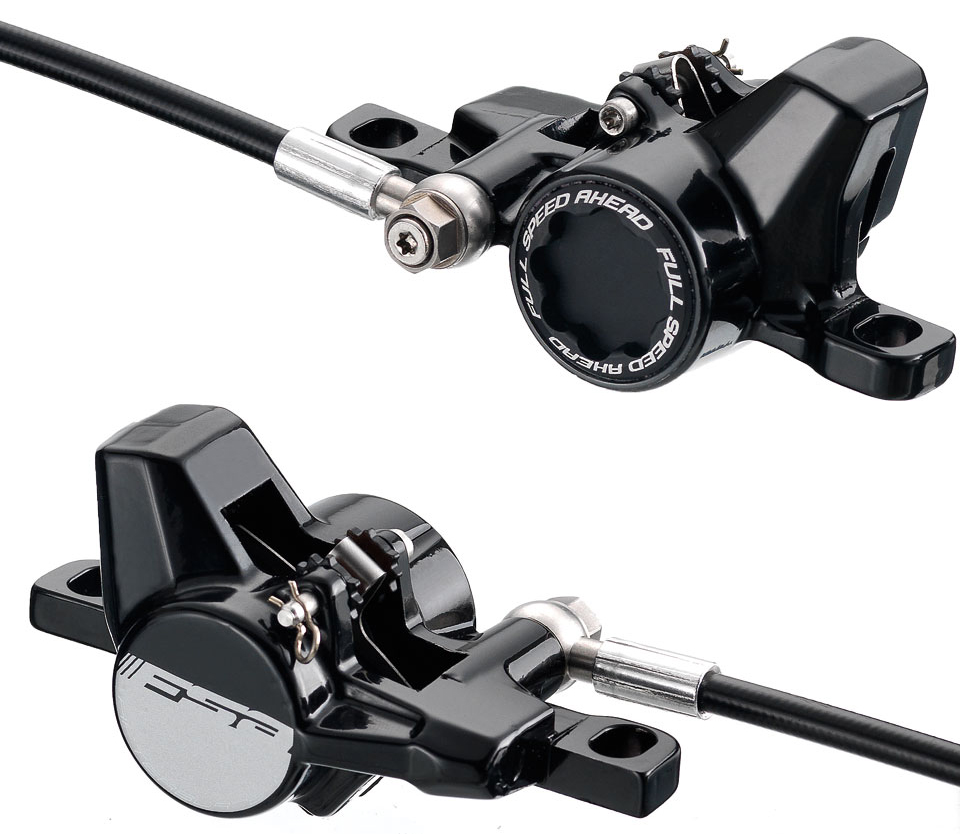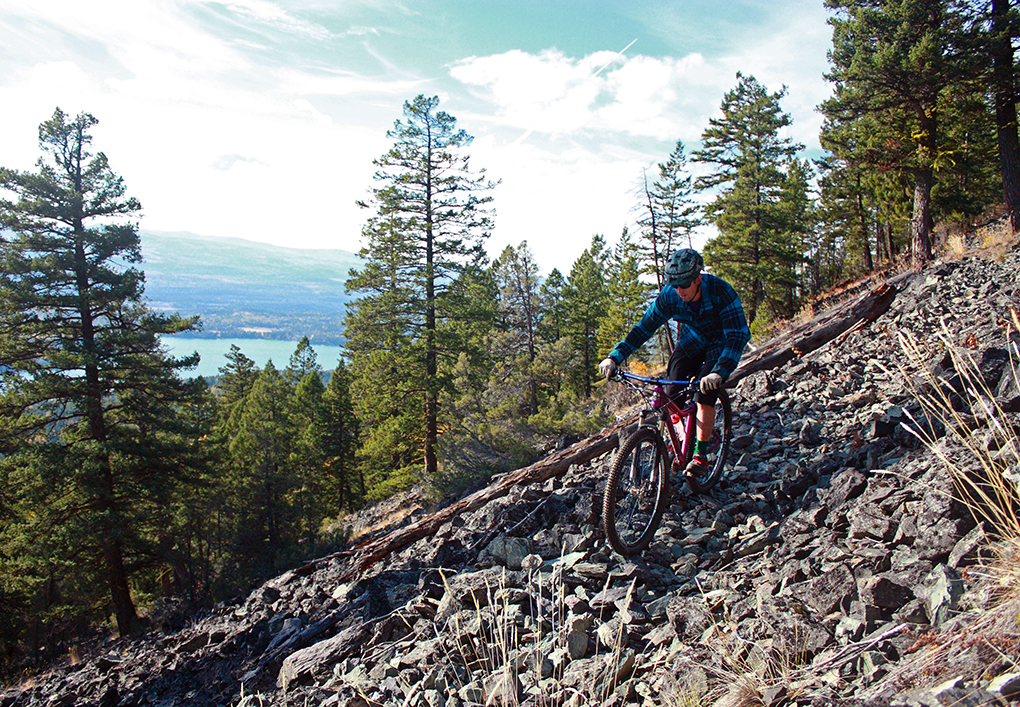
FSA Afterburner Disc Brakes
MSRP: $200 per brake (rotor not included)
Stated Weight: 393 grams
Blister’s Measured Weights:
- Rear brake (w/ mounting adaptor): 305 grams
- Front brake (w/ mounting adaptor): 276 grams
- 160mm Afterburner rotor (w/ bolts): 147 grams
- 180mm Afterburner rotor (w/ bolts): 177 grams
Features:
- Tool-free reach and stroke adjustments
- Differential front and rear hose stiffnesses
- FSA mineral oil and semi-metallic pads
- Aluminum alloy master cylinder body
- Aluminum alloy lever blade
- Forged 1-piece Al Alloy caliper body
Tested on: Canfield Yelli Screamy
Rider: 5’9”, 155 lbs.
Test location: Whitefish, MT
Test Duration: 2 months +
[Editor’s Note: We posted this review of the Afterburners last fall, but with more riding time, Noah Bodman has updated the review with a note about their durability. And FSA has drastically dropped the price on the Afterburners by $90 (see the “Price” section below), addressing one of our original, primary complaints about the brakes.]
FSA has waded into the world of disc brakes, and is offering two models: the higher-end K-Force, and the slightly less expensive, heavier Afterburner.
But while the K-Force sits at the top of FSA’s line, both brakes are positioned to compete with SRAM’s high end Guide brakes and Shimano’s XT and XTR series brakes.
Caliper & Lever Construction

The Afterburner calipers each use two 22mm pistons to generate their stopping power (the same size used in some of Shimano’s brakes).
The caliper is an aluminum monoblock, meaning that it is machined out of one chunk of forged aluminum. SRAM’s Guide brakes (the Guide R, RS, and RSC), and the Shimano XT feature a two-piece caliper that is bolted together. The advantage of the Afterburner calipers’ monoblock construction is that they are lighter than two-piece calipers, and offer better heat dissipation properties.
The calipers are also 100% compatible with Shimano pads—even Shimano’s Ice Tech cooling fin brake pads will fit the Afterburner calipers perfectly.
The Afterburner features a relatively straight aluminum lever blade (upgrading to the K-Force will get you a carbon lever blade). In terms of length, the Afterburner’s lever falls somewhere between the new SRAM Guides and the older Avid Elixir 9 Trail Brakes, and it’s quite a bit longer than the Shimanos (see picture below).

Some levers have a fair amount of “free stroke” movement before the system is pressurized and actually starts to move the brake pads. The Afterburners are designed with what FSA calls “quick draw braking” to address this, and when you pull the lever, the brake pads start moving and grab the rotors very quickly.
Hoses of different lengths are used to connect the Afterburner levers and calipers in the front and in the rear. The longer, rear hose is stiffer than that used in the front to ensure that the front and rear brakes have a similar feel (otherwise the rear brake can feel softer than the front).
Adjustments
The Afterburners feature the tool-free reach and stroke adjustments that one would expect of a high-end brake. The brakes’ stroke adjust is positioned similarly to the SRAM Guide RSC’s; it’s a small wheel built into the lever body. As with the Guide RSC’s, I found this wheel a little difficult to turn, especially once a bit of dirt had worked its way in there, and though the dial works as advertised, it doesn’t offer quite the same range of adjustment as the Guide RSC and Elixir 9 Trail brakes.
The Afterburners’ reach adjust dial, on the other hand, is better than that of any other set of brakes I’ve used. The reach knob is easy to turn, has defined clicks, offers a big of range adjustment, and is positioned in such a way that it’s less likely to break in a crash.
Installation
Installing the Afterburners was fairly uneventful. I was a little disheartened to see that FSA has followed the lead of companies like SRAM in using a hodgepodge of torx and hex fasteners to hold the Afterburners together, as it means I have to bring more tools with me if I need to fix something on the road. I’d rather FSA just use hex fasteners.
The perches for the Afterburner levers use a standard two-bolt mounting plate that keeps them stiff and secure. The only downside is that they’re not compatible with any integrated shifter mounting contraptions.

Bleeding
FSA’s bleed kit is similar to SRAM’s kit in that it uses syringes that thread into the caliper and lever. However, FSA brakes run on mineral oil (as do Shimanos) rather than DOT fluid like Avid / SRAM brakes. I’ve said in the past that I have a mild preference for DOT fluid because it’s easy to come by, but there’s no denying that DOT fluid is nasty stuff, and mineral oil is certainly much nicer to work with.
My first stab at bleeding the Afterburners was unsuccessful. I assumed I could just run some oil through the system, like I would in setting up a set of Avid brakes. But this produced poor results, with a bunch of air left in the system.
Most brakes I’ve bled over the years have utilized a more or less similar bleed process, but after stubbornly hacking around and re-bleeding the system a few times with similarly poor results, I finally buckled down and watched FSA’s instructional video. It turns out that the bleed process they’ve devised is a bit more in-depth, and takes a bit longer to perform (it involves using a couple different spacers with each caliper), but ultimately, it yielded very good results.
Aside from the slightly more complex bleed procedure, I noticed that the brakes’ bleed port screws have little rubber washers that don’t like to stay put. I managed to not lose them, but it’s something to watch out for when installing the Afterburners.
On the Trail
I like these levers was the first thing to pop into my mind when riding the Afterburners. I had no problem getting their reach and throw adjustments exactly where I wanted them, and the lever feel is just right; it doesn’t feel squishy, nor is it so firm that you can’t get some modulation out of the brakes.
Also, both the front and rear levers feel very similar, so apparently the stiffer hose on the rear brake achieves its intended purpose. I’ve used plenty of brake systems where the rear lever feels noticeably softer than the front, and that is definitely not true of the Afterburner.

After smoking (warped) some old XTR rotors this summer on a 30 minute long steep winding descent, I switched to the Freeza RT-99s and finned pads. Great upgrade for steep descending. On an actual downhill course though, I am on the brakes as little as possible, so possibly overkill.
Were you using FSA’s mineral oil for bleeding? Or did you use Shimano?